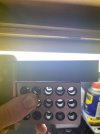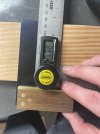So I bought a few new layout tools from Lee valley in an attempt to up my game a little bit. I am disappointed with the new 4 inch try square I received.
I checked the square against my 1-2-3 blocks and my digital angle finder. It’s off some ( angle finder says 0.3 of a degree).
Am I being too over the top? I think it’s border line whether it is worth complaining to Lee Valley. Maybe my expections were too high - if it was a dollar store square I would understand but I was hoping for more from a good woodworking supplier.
Interested in your thoughts. You can tell me I’m crazy if you need to!

I checked the square against my 1-2-3 blocks and my digital angle finder. It’s off some ( angle finder says 0.3 of a degree).
Am I being too over the top? I think it’s border line whether it is worth complaining to Lee Valley. Maybe my expections were too high - if it was a dollar store square I would understand but I was hoping for more from a good woodworking supplier.
Interested in your thoughts. You can tell me I’m crazy if you need to!


